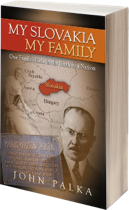Language Families
Travelers and linguists have long recognized that virtually every modern language shows an affinity for at least one other language, i.e. that the world’s languages can be grouped into families. One of the largest of those families is the geographically widespread group of Indo-European languages, ranging from Sanskrit and its numerous derivatives in South Asia, across the Iranian Plateau, to most of the languages of Europe. The European language groups include the Germanic (like German and Dutch), the Romance (like French and Spanish), and the Slavic.
Slavic languages are spoken from the Czech Republic and Slovenia in the west to the far reaches of Russia in the east. Most linguists recognize three divisions within the family:
- East Slavic, including Russian, Ukrainian, Belarusian, and Rusyn
- West Slavic, including primarily Czech, Slovak, and Polish
- South Slavic, including Bulgarian, Macedonian, Serbian, Croatian, Bosnian, Montenegrin, and Slovenian
In addition to these universally accepted languages, local dialects can be so distinctive that they are sometimes considered as separate languages. Altogether, Slavic languages are spoken by more people and over a larger territory than are the languages of any other European language family.
Czech And Slovak
No two languages in Europe are more closely related than Czech and Slovak. Today’s Czech speaking Czech can carry on a conversation with a Slovak speaking Slovak with surprisingly little difficulty. I can make my way in Prague almost as comfortably as in Bratislava, and have carried on more than one correspondence with a Czech colleague as if we were both writing in the same language. But clearly the languages are different—they have only partially overlapping vocabularies, some sounds are used in one but not the other (notably the Czech ř and the Slovak ľ (see Pronunciation Guide below), and the cadence is different.
Scholars continue to debate whether Czech and Slovak developed as two separate languages already in the distant past, or whether they evolved as a geographical sequence of dialects that would best be considered as a single language until it was deliberately split into two in recent times. Starting mainly in the 19th century, this question became closely linked to the issue of national identity, Czech and Slovak were each clearly defined, and today everyone accepts them as two closely related but separate languages irrespective of their mutual history.
Pronunciation Guide
Slovak was codified and became widely accepted as a literary, not merely a spoken, language only during the Slovak National Awakening of the mid-19th century. The orthography–the system of letters and symbols used to represent the actual sounds of the language–was developed at this time primarily by my great-granduncle Michal Miloslav Hodža and definitively systematized by the linguist Martin Hattala.
The system they put in place is still used, and it works extremely well. 23 of the 26 familiar letters of the Roman alphabet are used; q, w, and x are recognized only in foreign words. Modifications of the basic sounds are indicated by diacritical marks rather than by associating them with specific other letters. Here is how it works for vowels.
Any vowel can be sounded short or long. If it is short, it is unmarked. If it is long, it is marked by an accent mark over it. Two other diacritical marks are also used, as follows:
| Short | Sound | Long | Sound |
|---|---|---|---|
| a | up | á | argue |
| ä | Half-way between up and bad. | ||
| e | bed | é | fair |
| i | bit | í | beet |
| o | sport | ó | long |
| ô | quote | ||
| u | put | ú | snooze |
| y | ý | The difference between i and y is hard to hear and is not recognizable in all Slovak speech. It is maintained in spelling for historical reasons, but there are initiatives for eliminating the use of y altogether. |
A consonant can be hard, soft, or in some cases long, marked with diacritical marks as follows:
| Hard | Sound | Soft | Sound |
|---|---|---|---|
| c | fits | č | check |
| d | dog | ď | duration |
| l | long | ľ | approximated by ly |
| n | now | ň | news |
| t | toe | ť | tune |
| z | zoo | ž | pleasure |
- In all cases the diacritical mark indicating softness is a little check mark. However, when used with tall letters, modern printed text simplifies it.
- The distinction between the hard l and the soft ľ can be hard for English speakers to hear. It is more pronounced in some regions of Slovakia than in others.
- l, n and r can also be long, indicated by ĺ, ń, and ŕ, marked just as in the case of long vowels. We rarely use equivalent sounds in English words, but they are easily made as in brrr.
- j is always pronounced as a soft consonant. We would usually use y for that sound. The sound of our j, as in jury, would be spelled dž.
- One and only one modification of one consonant by a following consonant occurs: ch. In the alphabet it follows h, and it is pronounced as the same combination in the German ach or Nacht.
- Like many other languages, Slovak does not use the sound of the English th. t is the closest equivalent.
Here is how a sample English sentence would be spelled using Slovak orthography. Easy, right?
Hír iz hau a sämpl Ingliš sentens wud bí speld júzing Slovak ortografy. Ízi, rajt?
An excellent on line pronunciation guide is available.
